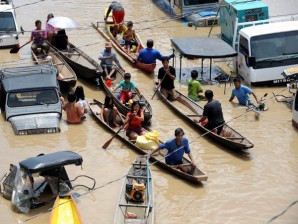The death toll from back-to-back Typhoons “Pedring” and “Quiel” that pummeled the country last week has risen to 82, the government said Thursday.
Several towns in Luzon were still flooded after Pedring struck on September 27 and Quiel five days later.
The death toll climbed dramatically from 58 after people reported missing earlier were confirmed dead, the Office of Civil Defense said.
Another 25 people remained unaccounted for, according to the office. More than half of the victims had drowned, it said, while the others died from accidents related to the typhoons.
Damage to infrastructure and agriculture has reached P9.5 billion, the OCD said.
Malacañang, meanwhile, on Thursday denied allegations that it was President Benigno Aquino III’s cancellation of flood-control projects that contributed to the widespread flooding that hit Central Luzon.
“The facts speak for themselves. Like I said, some of the projects were already completed,” said presidential spokesperson Edwin Lacierda in a news briefing in Malacañang.
Lacierda made the remark after Quezon Representative Danilo Suarez filed a House resolution calling for an investigation of the Aquino administration’s supposed cancellation of flood-control projects and its effects.
Lacierda said what was alluded to were negotiated contracts that were corrected due to some improper provisions.
“What (Public Works Secretary Rogelio) Singson did was to make sure that they were properly done. So they were bidded out and some of them have been completed,” Mr. Aquino’s spokesperson said.
In a related development, the Department of Trade and Industry vowed to strictly monitor the prices of basic and prime commodities after the agency imposed a price freeze in calamity-stricken areas.
Following Thursday’s National Price Coordinating Council meeting, Trade Undersecretary Zenaida Maglaya said the list of prices based on prevailing prices as of October 5 would be released by Saturday.
This, she said, should be the basis for pricing by all retailers covered by the freeze.
“We asked our provincial offices to submit to us (the prevailing prices of basic and prime commodities) in their areas. We’ll publish these in local newspapers and post them in markets and other places where people can readily see them,” Maglaya told reporters.
She said the DTI had also engaged the help of the Department of Agriculture and local government units in monitoring food prices.
She encouraged consumers to monitor prices and report violations of the freeze. Norman Bordadora and Abigail L. Ho; AFP
